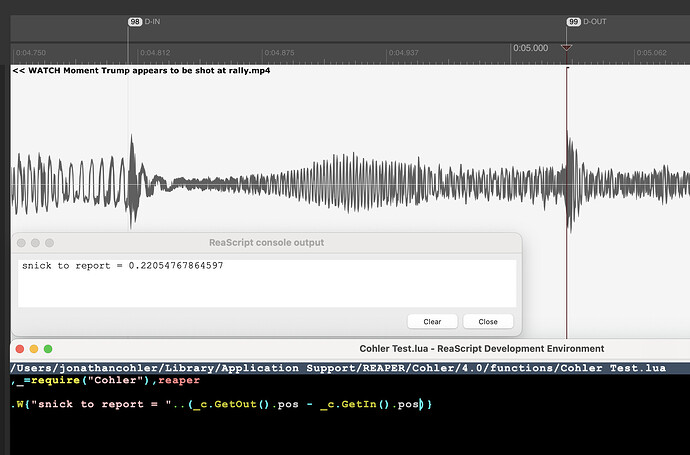Speed of sound is calculated as follows:
v = 331.3 m/s x sqrt(1 + T/273.15) x (1 + .0124 x H)
where T = temperature in ºC and H = relative humidity
According to Weather Underground at 5:51 pm:
T = 93ºF or 33.9ºC
H = 34% or 0.34
So v = 352.74 m / s = 1157 fps
The wind speed at that time was 7 mph or 10.3 fps WNW almost perpendicular to the shot direction of SSW. I estimate a -2 fps affect on the speed bringing v = 1155 fps
We don’t need to speculate on the snick-report time. It IS what it IS.
Average loss of speed due to air friction including the wind speed / direction is likely in the 1.7% to 2% over the entire range of 400 to 450 ft for a 55 grain round.
55 grain rounds
Muzzle velocity of 3000 fps x .98 = 2940 fps
d = .2205 / (1/1155 - 1/2940) = 419 ft
With a bullet speed of 3250 fps x .98 = 3185 fps
d = .2205 / (1/1155 - 1/3185) = 400 ft
With a bullet speed of 2800 fps x .98 = 2744 fps
d = .2205 / (1/1155 - 1/2744) = 440 ft
A 77-grain round has somewhat less drag, so the speed could be 2700 fps x .985 = 2660 fps:
d = .2205 / (1/1155 - 1/2660) = 450 ft
Crooks muzzle was 454 ft away.
CONCLUSIONS:
If the rounds were 55 grain bullets then:
THERE WAS A 2nd SHOOTER about 40 feet closer to Trump.
THAT IS EXACTLY THE DISTANCE TO THE FRONT EDGE OF THE BUILDING.
If the rounds were 77 grain bullets then:
Crooks could have been the shooter.
WE NEED TO KNOW WHAT THE BULLETS WERE.
THE FBI KNOWS AND PROBABLY HAS THEM.
WHY ARE THEY HIDING THEM?
IF THE ROUNDS ARE 55 grain, then THERE WAS A 2nd SHOOTER.
P.S. The 2nd and 3rd shots have times of 215ms and 209ms between snick and report. Those would imply correspondingly shorter distances than the ones calculated above by about 2.3% and 5% respectively. That makes it even a further stretch for Crooks to have been the shooter of those rounds.
